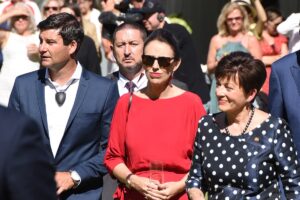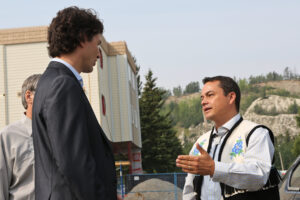New Zealand’s Tribunals are a Model for Canadian Reconciliation

After securing the majority of the seats in New Zealand’s Parliament in the October election, the centre-right National Party is poised to form government. The usual big-ticket election concerns, like the economy and healthcare, dominated the election, but issues concerning the Maori—who make up some 17 per cent of the population— also remained prominent. The prominence resonates beyond New Zealand’s shores, notably here in Canada, where reconciliation with Indigenous peoples similarly shapes the political discourse. Yet, despite these parallels, cross-cultural comparisons between these two commonwealth countries remain infrequent.
At the heart of reconciliation in New Zealand lies the Waitangi Tribunal, an entity independent of the New Zealand Crown. The Tribunal was established to investigate the Crown’s breaches of the Treaty of Waitangi, which was signed in 1840 between the British Crown and 500 Maori political leaders to create a system of cohabitation amidst the increasing settler population.
Instead of ensuring Maori governance and welfare, Crown treaty breaches stripped Maori of their lands, subordinated Maori political power, and led to the deterioration of Maori welfare indicators, such as health and income, falling below those of the settler population. Maori life expectancy is around 7 years lower compared to non-Maori.
To hold the government accountable, the Tribunal has the exclusive right to interpret the meaning of the Treaty of Waitangi and make recommendations to the government to issue apologies, return land, and enforce resource rights which remedy breaches of the Treaty. The Chairperson is a Chief Judge of the Maori Land Court, while the other 20 members have a wide range of relevant expertise in fields including Tikanga Maori (Maori customs) or law, with about half being Maori and half settlers. The Tribunal can compel representatives of the Crown, Maori nations (Iwi), and private actors like energy companies to participate in the hearings.
According to Dr. Tom Roa, a University of Waikato professor and Tribunal member, the Tribunal’s mandate only extends to making recommendations. However, the recommendations are then brought to settlement negotiations where “the Crown pays heed to the Tribunal, and Iwi use the findings assertively.”
By compelling opposing groups to gather together and listen to different perspectives, the Tribunal fosters consensus and reasonableness that is brought to the negotiating table when reaching a settlement.
Settlements negotiated with the Crown as a result of the Tribunal have given Iwi hundreds of millions of dollars, tracts of land, and self-governance rights.
The Tribunal also provides a space for Maori to share their stories of oppression at the hands of the Crown. Te Kahautu Maxwell, an Associate Professor at the University of Waikato, explains that “tribes can have their horror stories heard and recorded, and it’s an opportunity to grieve.”
Dr. Roa asserts that the Tribunal is “central to the reconciliation process […] and shows that [Maori] are important as a people.”

The Waitangi Tribunal, pivotal to New Zealand’s reconciliation process, offers a compelling blueprint for addressing Indigenous grievances, which is relevant in Canada amidst the ongoing treaty and land claims negotiations. Surprisingly, however, a similar tribunal already exists: The Specific Claims Tribunal. And at first glance, it appears to wield greater authority than its Kiwi counterpart.
The Specific Claims Tribunal, established in 2008, aims to resolve Indigenous nations’ claims made against the Canadian Crown for breaches of treaties and obligations for reserve lands. The Tribunal operates like a courtroom with Superior Court Justices presiding and, like the Waitangi Tribunal, is independent from the Crown. But what makes Canada’s Tribunal distinct—and arguably more powerful—is that it can independently make awards of up to $150 million.
The roots of the Specific Claims Tribunal are in the 1996 Report of the Royal Commission on Aboriginal Peoples. The report called for the creation of independent tribunals to arbitrate Indigenous nations’ specific and comprehensive claims against the Crown.
Specific claims are breaches by the Crown of its obligations outlined in treaties and other agreements with Indigenous nations. Comprehensive claims refer to claims over areas of land that were not ceded to the Crown in treaties, and Indigenous nations claim ownership—settlers often reside in these areas. They are especially prominent in British Columbia, where 95% of the province is on unceded territory.
Despite the report’s recommendations, the Specific Claim Tribunal’s mandate only applies to specific claims. The process for settling comprehensive claims involves lengthy negotiations—often decades-long—between Indigenous nations and the Crown or a gruelling process through Crown courts. Proceedings are complicated because settlers frequently live on the land negotiated over. The settlements usually involve the return of land, money, and self-governance rights to Indigenous nations. In B.C. alone, there are 60 ongoing comprehensive claims negotiations.
The rationale for an independent tribunal in both Canada and New Zealand arises from the conflict of interest present when claims against the Crown are settled in Crown courts or institutions: the Crown is both the defendant and the judge. John Borrows, the Loveland Chair in Indigenous Law at the University of Toronto and Canada Research Chair in Indigenous Law, explained that an independent tribunal is a form of “checks and balances” to ensure that settlements are fair.
Unlike the Waitangi Tribunal, claims go before the Canadian Tribunal if negotiations with the Crown have lasted for over three years or if the Crown rejects the claim for negotiation.
As of 2022, 135 claims have been brought before the Tribunal, and hundreds of millions of dollars have been given to Indigenous nations. Yet, despite the large dollar figures dispensed, in comparison to the Waitangi Tribunal, the Specific Claims Tribunal can not provide compensation that is nation-building for Indigenous nations.
Professor Borrows explained that “in the Waitangi process, claims are not just about technical breaches but also present controversies like oil and gas or intellectual properties or even airwaves.” This broad scope of the Waitangi Tribunal has led to a variety of reparations, including transfers of land, co-governance arrangements, and fishing and other resource rights. Borrows emphasized that the Waitangi Tribunal allows the Treaty of Waitangi to be an “instrument for future governance, not a once upon-a-time thing.”
The Specific Claim Tribunal’s mandate, along with the Waitangi Tribunal, is to create a venue for mediated negotiations. But, as of 2022, only 32 per cent of claims filed at the Specific Claims Tribunal were attempted to be settled through negotiations. By contrast, 90 per cent of civil claims in Canada are resolved without trial through negotiations. Justice Harry Slade, Chairperson of the Specific Claims Tribunal from its founding until 2021, explained how the purpose of a Tribunal is to facilitate negotiation and consensus—not enforce decisions.
In 2022, the Assembly of First Nations submitted a reform proposal for the specific claims process. The reform would create a commission and resource hub, working in conjunction with the Tribunal, where the parties can negotiate a settlement. Justice Slade believes that the proposal is a positive step that “foster[s] negotiated settlements rather than having authorities make binding decisions.” If implemented, it would lead to a specific claims process that functions similarly to the Waitangi Tribunal as a forum to facilitate negotiations but would have the added power to independently award up to $150 million through the Tribunal.

However, the reform proposal will not address the absence of a tribunal to settle comprehensive claims. Not only is a tribunal called for by the RCAP report but Canada is required to create such a process as a signatory to the United Nations Declaration on the Rights of Indigenous Peoples.
Justice Slade argued for such a forum to arbitrate comprehensive claims. “It should have powers […] to compel participation in discussion between government and stakeholders,” he explained and added that private property holders and parties, such as municipalities, who control land included in Indigenous title claims, should be included in the negotiations, which is resisted by many Indigenous political leaders. He pointed to the Waitangi Tribunal, where including private interests “contributed to successful negotiated outcomes.”
According to Justice Slade, neither Indigenous nations nor the Canadian Crown shows motivation for a comprehensive claims tribunal to award compensation independently due to the “complexity of comprehensive claims.”
However, the establishment of an independent tribunal akin to New Zealand’s could enhance the process of negotiations between the Crown, Indigenous nations, and private interests. Such a body would play a pivotal role in ensuring all parties engage in good faith and work towards a consensus on comprehensive claims. This approach would mark a substantial shift from the current protracted and often contentious negotiations, which can span decades or are held through courts where the Crown is both the judge and defendant.
Edited by Elena Lee.
Featured image: Proclamation of accession ceremony for King Charles III in New Zealand’s capital, Wellington. Maori leaders and politicians, including incoming Prime Minister Christopher Luxon, are present. “New Zealand Herald Extraordinary” by Mark Tantrum is licensed under CC BY-SA 4.0.”
